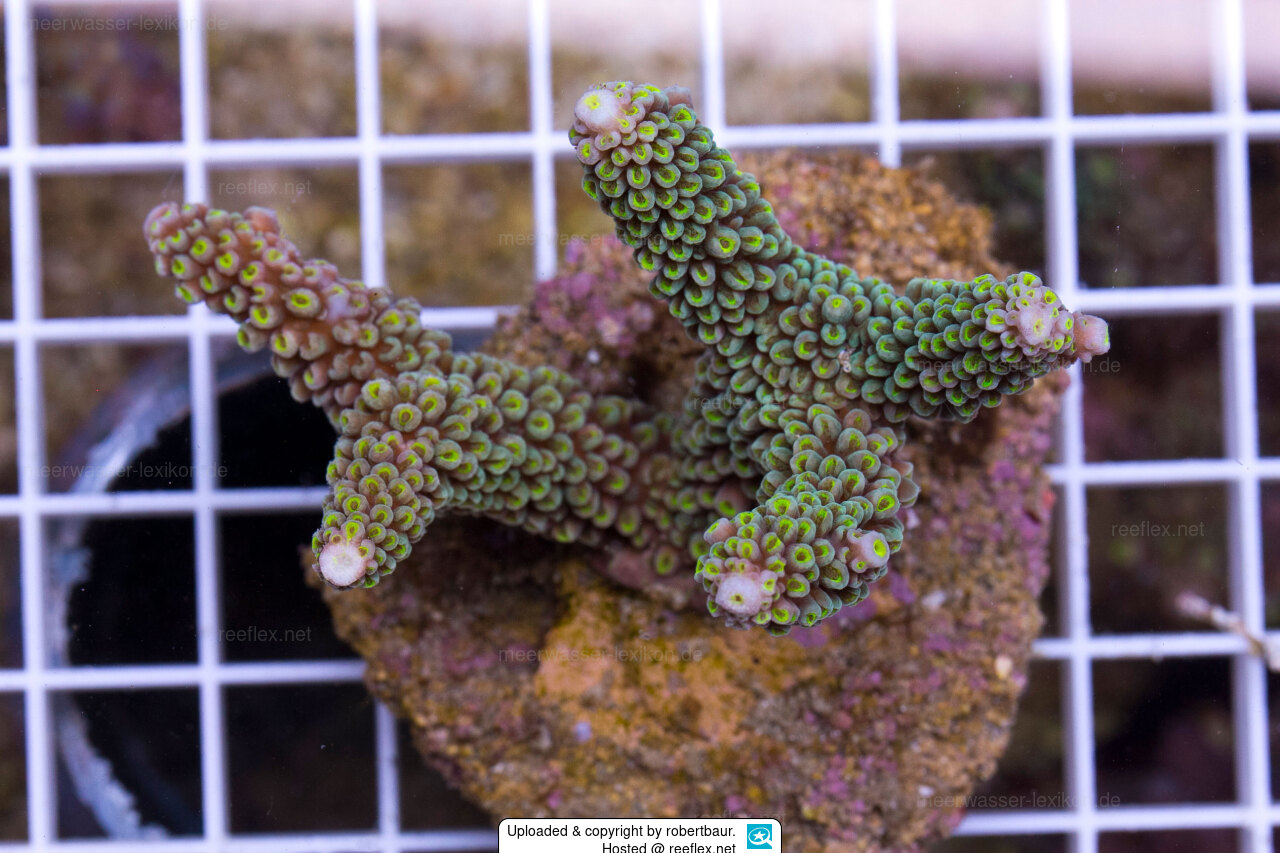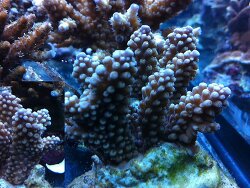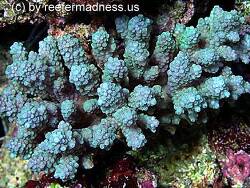Info
Characters:
Colonies are upright or prostrate tangles of branches up to one metre across. Branches are thin and delicate. Axial corallites are long and tubular. Radial corallites are mostly small and tubular to pocket-shaped with sharp edges.
Similar Species: Acropora filiformis. See also Acropora kirstyae, which has thicker branches and corallites with rounded edges
Corals of the genus Acropora
Hard corals are reef-building, oceanic invertebrates, sessile and colony-forming cnidarians that form a calcareous skeleton. They live mainly on light via their zooxanthellae, but are also able to catch plankton with their polyps. They extract calcium and, to a lesser extent, other elements from seawater, producing several grams of calcium per day. They also formed the coral reefs known today to a large extent.
The species of the genus Acropora are often very colorful and their long-term successful keeping has been considered high art for many years. They have been kept in aquariums since the late 1980s and then even multiplied many times over the course of the 1990s. Cult husbandry and asexual reproduction quickly became popular. Today, in addition to commercial breeders, private aquarists also offer coral offshoots.
The propagation of hard corals is very easy, since they ultimately only have to be fragmented. You break off a piece of the mother coral and the offshoot obtained in this way grows (usually glued to a piece of live rock), similar to plant offshoots, into its own coral stock under good conditions.
Hard corals are divided in hobby circles, roughly based on the size of their polyps, into small polyp scleractinians (small polyp or SPS corals) and large polyp scleractinians (large polyp or LPS hard corals).
Not all SPS corals are created equal in their husbandry needs. Again, there are species that are less sensitive than others.
General:
Taxonomists today assume that there are 18 hard coral families with a total of over 100 genera.
The two genera Montipora (over 70 species - Veron 2000) and Acropora (over 180 species - Veron 2000) are among the most species-rich and numerous.
The maintenance of small-polyp stony corals was and is usually far more complex than that of most LPS corals and zooxanthellate soft corals due to the corals' requirements for water quality and lighting.
With the development of high-performance skimmers and the use of living rock, a much better water quality in the aquarium could be guaranteed. In addition, better lighting and an automated, continuous supply of calcium enabled the corals to be kept and reproduced over the long term.
Since keeping SPS corals has become an achievable goal for many aquarists, zooxanthellate soft corals are of little interest to most aquarists.
Identifying small polyp and large polyp hard corals is not always easy, despite really good reference books like Veron's book "Corals of the World". Ultimately, a clear identification is only possible on the basis of precise examinations of the calcareous skeleton, or by means of complex DNA analyses.
It should also not be forgotten that many animals in the aquarium no longer look like they do in nature and their appearance changes due to currents, light and other influences.
Among the important parameters:
Light:
All small-polyp hard corals from the genus Acropora need a very high light intensity.
They should therefore be placed at the top of the tank with average lighting.
heat/cold:
Corals of the genus Acropora do not tolerate water temperatures below 20 or above 30 degrees for a long time.
In both cases, this will lead to fading.
Flow:
They tolerate quite a good current. However, the pump outlet should not be aimed directly at a coral.
Changing, rather turbulent flow conditions are best suited.
Water parameters:
Trace elements (calcium 420-440 mg/L, magnesium 1100-1300 mg/L, KH below 8, strontium 8 mg/L). Water changes: at least 5% per week or 10% per month.
water quality:
Water that is as permanently stable and clear as possible, if necessary, carbon filtering or ozonation is useful to remove yellow substances.
The bucket comparison (2 white containers of the same size: freshly prepared water in one, aquarium water in the other) then quickly shows whether the water in the aquarium is as clear as the fresh water.
Acropora hard corals don't like standing in a yellow broth.
Nitrate NO3:
less than 5mg/L.
Phosphate PO4:
less than 0.1 mg/L, better even in the range of 0.01 mg/L.
While large-polyp stony corals can usually cope with higher nutrient values, small-polyp stony corals often quickly lose their color or the growth of the animals is restricted.
Corals that used to be colorful quickly turn an often unsightly brown. This is due to the higher supply of nutrients. The more nutrients, the more zooxanthellae form and lead to a dark brown tone in the animal.
If there is an oversupply or an imbalance of nutrients over a longer period of time, this can lead to tissue breakdown and thus to the death of the coral stock.
Last but not least:
Let's not forget the animal and environmental protection aspect that all coral growers are now doing.
The more offshoots, the fewer withdrawals from nature. A lot has happened in this area over the years. Corals from aquaculture are preferred today and sold as offspring.
Colonies are upright or prostrate tangles of branches up to one metre across. Branches are thin and delicate. Axial corallites are long and tubular. Radial corallites are mostly small and tubular to pocket-shaped with sharp edges.
Similar Species: Acropora filiformis. See also Acropora kirstyae, which has thicker branches and corallites with rounded edges
Corals of the genus Acropora
Hard corals are reef-building, oceanic invertebrates, sessile and colony-forming cnidarians that form a calcareous skeleton. They live mainly on light via their zooxanthellae, but are also able to catch plankton with their polyps. They extract calcium and, to a lesser extent, other elements from seawater, producing several grams of calcium per day. They also formed the coral reefs known today to a large extent.
The species of the genus Acropora are often very colorful and their long-term successful keeping has been considered high art for many years. They have been kept in aquariums since the late 1980s and then even multiplied many times over the course of the 1990s. Cult husbandry and asexual reproduction quickly became popular. Today, in addition to commercial breeders, private aquarists also offer coral offshoots.
The propagation of hard corals is very easy, since they ultimately only have to be fragmented. You break off a piece of the mother coral and the offshoot obtained in this way grows (usually glued to a piece of live rock), similar to plant offshoots, into its own coral stock under good conditions.
Hard corals are divided in hobby circles, roughly based on the size of their polyps, into small polyp scleractinians (small polyp or SPS corals) and large polyp scleractinians (large polyp or LPS hard corals).
Not all SPS corals are created equal in their husbandry needs. Again, there are species that are less sensitive than others.
General:
Taxonomists today assume that there are 18 hard coral families with a total of over 100 genera.
The two genera Montipora (over 70 species - Veron 2000) and Acropora (over 180 species - Veron 2000) are among the most species-rich and numerous.
The maintenance of small-polyp stony corals was and is usually far more complex than that of most LPS corals and zooxanthellate soft corals due to the corals' requirements for water quality and lighting.
With the development of high-performance skimmers and the use of living rock, a much better water quality in the aquarium could be guaranteed. In addition, better lighting and an automated, continuous supply of calcium enabled the corals to be kept and reproduced over the long term.
Since keeping SPS corals has become an achievable goal for many aquarists, zooxanthellate soft corals are of little interest to most aquarists.
Identifying small polyp and large polyp hard corals is not always easy, despite really good reference books like Veron's book "Corals of the World". Ultimately, a clear identification is only possible on the basis of precise examinations of the calcareous skeleton, or by means of complex DNA analyses.
It should also not be forgotten that many animals in the aquarium no longer look like they do in nature and their appearance changes due to currents, light and other influences.
Among the important parameters:
Light:
All small-polyp hard corals from the genus Acropora need a very high light intensity.
They should therefore be placed at the top of the tank with average lighting.
heat/cold:
Corals of the genus Acropora do not tolerate water temperatures below 20 or above 30 degrees for a long time.
In both cases, this will lead to fading.
Flow:
They tolerate quite a good current. However, the pump outlet should not be aimed directly at a coral.
Changing, rather turbulent flow conditions are best suited.
Water parameters:
Trace elements (calcium 420-440 mg/L, magnesium 1100-1300 mg/L, KH below 8, strontium 8 mg/L). Water changes: at least 5% per week or 10% per month.
water quality:
Water that is as permanently stable and clear as possible, if necessary, carbon filtering or ozonation is useful to remove yellow substances.
The bucket comparison (2 white containers of the same size: freshly prepared water in one, aquarium water in the other) then quickly shows whether the water in the aquarium is as clear as the fresh water.
Acropora hard corals don't like standing in a yellow broth.
Nitrate NO3:
less than 5mg/L.
Phosphate PO4:
less than 0.1 mg/L, better even in the range of 0.01 mg/L.
While large-polyp stony corals can usually cope with higher nutrient values, small-polyp stony corals often quickly lose their color or the growth of the animals is restricted.
Corals that used to be colorful quickly turn an often unsightly brown. This is due to the higher supply of nutrients. The more nutrients, the more zooxanthellae form and lead to a dark brown tone in the animal.
If there is an oversupply or an imbalance of nutrients over a longer period of time, this can lead to tissue breakdown and thus to the death of the coral stock.
Last but not least:
Let's not forget the animal and environmental protection aspect that all coral growers are now doing.
The more offshoots, the fewer withdrawals from nature. A lot has happened in this area over the years. Corals from aquaculture are preferred today and sold as offspring.







 robertbaur
robertbaur


























































































































































